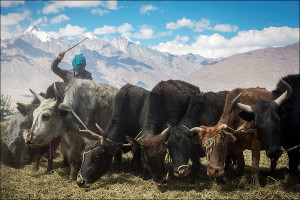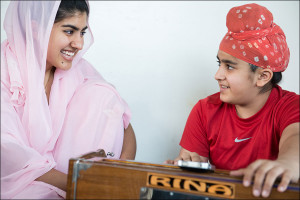Curiosity and Passion Leads Grant Recipient to Pursue Global Photojournalism
Master’s Student Neeta Satam Is the Winner of the $12,000 O.O. McIntyre Fellowship
By Kiara Ealy
Columbia, Mo. (April 26, 2016) — In her years since arriving in the U.S. in 2001, Missouri School of Journalism student Neeta Satam has completed a master’s degree in environmental sciences, worked as an environmental scientist and become a photojournalist who has visually documented rural America, Eastern Europe and Asia.

Now, she’s about to conquer her latest endeavor – earning a third master’s degree in photojournalism: “My photography explores the themes of cultural assimilation, human identity and the environment.”
Along the way, Satam has been awarded the School’s Duffy Grant to complete a project on the Sikh community in the Midwest.
“During a trip to St. Louis, I saw a turbaned Sikh in a supermarket,” Satam said. “As an immigrant, I empathize with the pressure some immigrants face to culturally assimilate in the mainstream society. As the man walked past me, I realized this is a story worth telling.”
With the image of the man in the market stuck in her mind, Satam pitched the story idea and won the grant in summer 2014.
Later, she and classmate Ryan Schuessler were published in The Guardian for their work covering the Sikh community in Oak Creek, Wisconsin, which had faced a violent hate crime in August 2012.
“The project made me realize that Sikh men not only face the pressure to culturally assimilate in the American society, but also hate crimes in the post 9/11 world,” Satam said.
She credits receiving the Duffy Grant to wanting to further question and broaden her research.
“The advantage of a grant is not only the financial ability it provides to pursue a project but also a sense of personal accountability it creates to complete the project,” Satam said. “Applying to the grant was a great learning experience because it pushed me to research the issue, draft the proposal, carve out time to gain access, finish the project and get it published.”

Satam recently returned from Asia to shoot her master’s project on the “resilience and adaptation” of some of the first Himalayan climate refugees in the Zanskar Region. She was embedded in a community that is losing its sole source of water to climate change.
“The issue of climate change in the Indian Himalayas is under-reported in international media because it is a sensitive international border region,” she said.
Executing the project in the field was challenging, Satam said. The Zanskar region, formerly a part of western Tibet, is a remote mountainous area in India-administered Kashmir that remains isolated from the world for almost seven months in a year. The area is one of the most militarized parts of the world where journalists are under tremendous scrutiny. Shooting in Zanskar was also challenging, Satam said, because it is an unforgiving terrain as far as the weather and altitude is concerned.
Satam’s project committee, photojournalism faculty Jackie Bell and Rick Shaw, helped her plan the logistics of the field component of her master’s project.
“Their encouragement and support helped me overcome numerous challenges associated with shooting the project,” Satam said.
She was awarded the Correspondents’ Grant and the Richard Oliver Scholarship to complete the project. In just a short amount of time, Satam has found a passion in storytelling and giving a voice to those who cannot be heard.

After growing up in India and pursuing other dreams, Satam chose the Missouri School of Journalism and its hands-on method in photojournalism. She received a Jack and Dorothy Fields Scholarship to attend the Missouri Photo Workshop. Participants shoot a story and attend photo critiques and lectures. The rest of her time at the School is history.
“David Rees encouraged me to visit the J-School and sit on a couple of graduate classes,” Satam said. “After doing so, I had no second thoughts on applying to the program. I was drawn towards the intellectual rigor of the curriculum. I saw there was a tremendous potential to learn from J-School initiatives such as the Pictures of the Year International, Missouri Photo Workshop and College Photographer of the Year.”
Satam’s latest accolade has been the O.O. McIntyre Writing Fellowship, which is the School of Journalism’s highest postgraduate award. The $12,000, one-year award will help cover the continuation of her master’s work on the Himalayas, the third largest body of ice and snow (after the Arctic and Antarctic), and hence is often referred to as the “third pole.”
Satam is currently editing her master’s project and plans to defend it in the fall.
Updated: September 24, 2020
Related Stories
Expand All Collapse All- 2024
- 2023
- 2020
-
2019
- Oct 07, 2019 Journalism students spend summer gaining hands-on work experience while immersing themselves in other cultures
- Sep 30, 2019 Strategic Communication student Cullen Ecoffey gains video experience and perspective during summer trip
- Aug 19, 2019 Jennifer Mosbrucker Awarded O.O. McIntyre Fellowship
- Jun 12, 2019 Journalism Students, Alumni Gain Hands-On Experience Covering Missouri Tornado Devastation
- May 29, 2019 More than victims: Migration images provide a chance to tell a greater story
- May 14, 2019 Associate Professor Berkley Hudson Awarded $150,000 National Endowment for Humanities Grant
- Feb 08, 2019 Photo Story: 'Standing Up' by Emily Nevils
- Feb 08, 2019 Photo Story: "Sam" by Maddie Davis
-
2018
- Dec 05, 2018 Two-Person Reporting Team to Cover Nobel Prize Ceremonies in Wire-Service Pop-Up-Type Newsroom Setting
- Oct 30, 2018 David Rees Named to Missouri Photojournalism Hall of Fame
- Aug 07, 2018 Missouri Students Teach International Teens about MU Photojournalism Program
- Jul 25, 2018 Scholarship to Help Photojournalism Graduate Student Document Burmese People Resettled in U.S.
- May 24, 2018 Global Journalist Wins Two 'Telly' Awards for Online Videos
- May 16, 2018 Special Public Exhibit Showcases Work of Graduating Photojournalism Students
- Mar 23, 2018 Pulitzer Prize-Winning Photographer to Present 'The Human Toll of Toxic Pollution'
- Jan 10, 2018 Annie Rice Named Recipient of the C. Zoe Smith Scholarship in Photojournalism
-
2017
- Nov 01, 2017 J-School's 'Global Journalist' Signs Distribution Agreement with KMUD Radio in Northern California
- Sep 08, 2017 Recent Photo-J Grad Starts Work July 1; Harvey Hits Less Than Two Months Later
- Jun 19, 2017 Grad Student Evan Cobb Awarded C. Zoe Smith Photojournalism Scholarship
- May 11, 2017 Alumna Laurie Skrivan Wins 2017 RFK Photojournalism Award
- Mar 27, 2017 Professional Journalists Pair Up Students in Missouri and India for Reporting Project
- Mar 07, 2017 Missouri Journalism Senior Wins Prestigious OPC Foundation Award
- Feb 13, 2017 Journalism Students Document Mass Sea-Turtle Nesting on Costa Rica Trip
- Jan 17, 2017 Annie Rice Places in Top 10 in National Hearst Multimedia Competition
-
2016
- Nov 01, 2016 New Benchmark Established with Publishing of Virtual Reality Feature
- Aug 30, 2016 Missouri Students Document Life in South Africa
- Jul 20, 2016 Photojournalism Master's Student Wins International Award
- May 27, 2016 Adam Vogler Named Inaugural Recipient of C. Zoe Smith Photojournalism Scholarship
- May 20, 2016 Foreign Press Association Awards Aleksandr Gorbachev $10,000 First Place Scholarship
- Apr 26, 2016 Curiosity and Passion Leads Grant Recipient to Pursue Global Photojournalism
- Mar 22, 2016 Photojournalists to Present 'Beyond the Protest' Program at J-Day on April 6
- Feb 08, 2016 Photojournalism Senior Wins Grand Prize in MU Arts Competition
-
2015
- Dec 22, 2015 Tim Tai Places Second in Hearst Photojournalism Competition, Wins $2,000
- Nov 30, 2015 Work of 4 Photojournalism Students Featured in Time Magazine's LightBox
- Nov 17, 2015 Photojournalism Program Featured in National Photo District News Magazine
- Jun 12, 2015 Caleb O'Brien Wins $12,000 O.O. McIntyre Fellowship
- 2014
- 2013
-
2012
- Dec 01, 2012 Free Screening of Students' Multimedia Documentaries to Be Held Dec. 4 at Ragtag Cinema
- Sep 10, 2012 Pulitzer Prize-Winning Exhibit Now on Display at the School
- Sep 04, 2012 School's Photojournalists Win Third Place in 'Best Use of Photography' National Competition
- Apr 30, 2012 Master's Student Wins $12,000 McIntyre Fellowship
- 2011
-
2010
- Apr 26, 2010 Pat Smith Is Honored with the MU 2010 International Engagement Award
- Apr 26, 2010 Patrick Fallon Named a Hearst National Photojournalism Semi-Finalist
- Apr 05, 2010 Patrick Fallon NPPA's New Student Board Representative
- Mar 16, 2010 The 'Global Journalist' Radio Program Celebrates Its 10th Anniversary with the Premiere of New Interactive and Video Features
- 2009
- 2008
-
2007
- Oct 26, 2007 Celebrated Photojournalist Delivers Two-day Seminar on Fundamentals of Web Video
- Jun 29, 2007 Missouri School of Journalism Places Second Overall in 2006-2007 Hearst Competition, Wins $22,750 in Prizes
- May 01, 2007 Journalism Students Practice Reporting from Field During Spectacular Crane Migration
- Apr 25, 2007 Missouri School of Journalism Senior Wins $12,000 O.O. McIntyre Fellowship to Document "Lost Boys of Sudan" Reunion in Africa
- Feb 08, 2007 Woodward Joins Photojournalism Faculty at Missouri School of Journalism
- 2006
- 2005
- 2004
- 2003